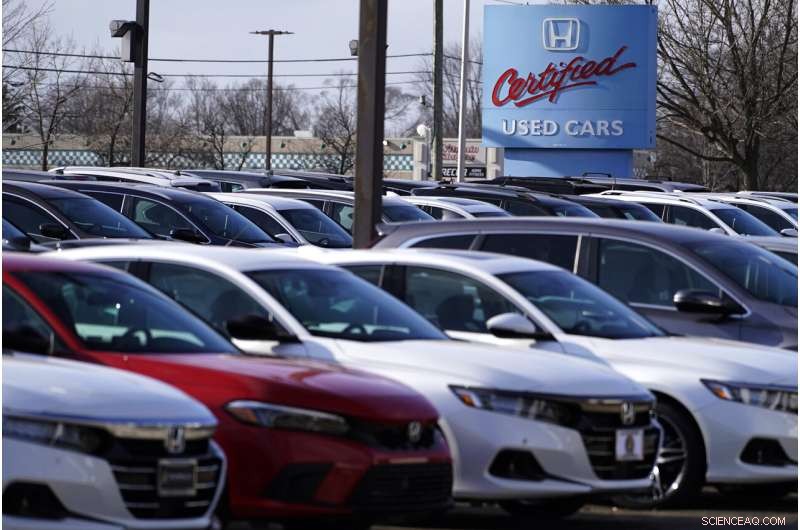
Un panneau de concession est visible à l'extérieur du concessionnaire de voitures d'occasion certifié Honda à Schaumburg, Illinois, le jeudi 16 décembre 2021. Les prix des voitures d'occasion ont grimpé si haut, si vite, que les acheteurs sont de plus en plus exclus du marché. Crédit :AP Photo/Nam Y. Huh
Il y a quelques mois, une femme a rendu visite au parc de voitures d'occasion de Jeff Schrier à Omaha, Nebraska. Elle avait un budget serré, a-t-elle dit, et cherchait désespérément un véhicule pour se rendre au travail.
On lui a montré trois voitures au prix de sa limite, environ 7 500 $. Schrier a dit que la femme était stupéfaite.
"'C'est ce que j'obtiens pour 7 500 $?'" se souvient-il avoir dit. Les véhicules avaient beaucoup plus d'âge ou de kilométrage que ce à quoi elle s'était attendue pour remplacer une voiture qui avait été détruite dans un accident.
La femme a finalement opté pour une Toyota Scion 2013 avec 160 000 miles. Schrier n'est pas sûr d'avoir réalisé un profit sur l'accord. "Nous l'avons simplement aidée", a-t-il déclaré.
Alors que les prix des véhicules d'occasion dépassent tout niveau apparemment rationnel, c'est le genre de scénario qui se déroule chez de nombreux concessionnaires automobiles à travers le pays. Les prix ont grimpé si haut, si vite, que les acheteurs sont de plus en plus exclus du marché.
Considérez que le prix moyen d'un véhicule d'occasion aux États-Unis en novembre, selon Edmunds.com, était de 29 011 $, soit 39 % de plus que 12 mois plus tôt. Et pour la première fois dont tout le monde s'en souvienne, plus de la moitié des ménages américains ont un revenu inférieur à ce qui est considéré comme nécessaire pour acheter le véhicule d'occasion au prix moyen.
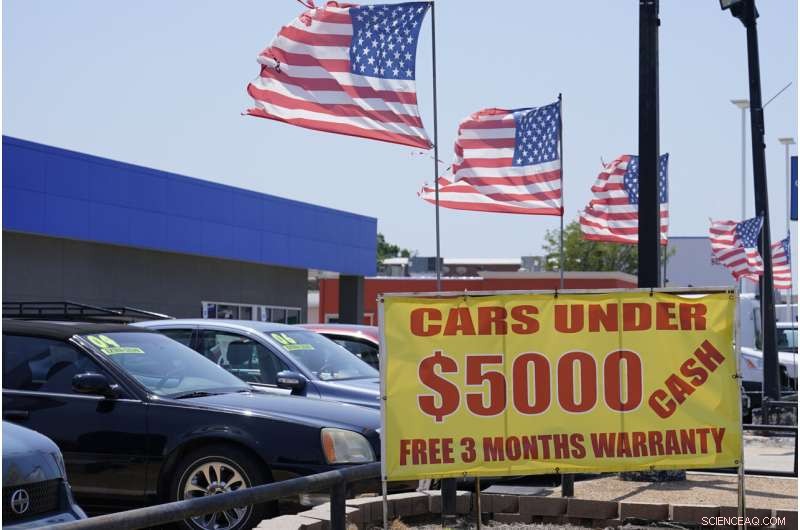
Des voitures d'occasion à vendre sont exposées le jeudi 24 juin 2021 à Oklahoma City. Les prix des voitures d'occasion ont grimpé si haut, si vite, que les acheteurs sont de plus en plus exclus du marché. Crédit :AP Photo/Sue Ogrocki
L'époque où à peu près n'importe qui avec un revenu stable pouvait se promener sur un parking et s'emparer d'une voiture fiable de modèle récent ou acheter le premier véhicule de son enfant pour quelques milliers de dollars est pratiquement révolue.
"Je n'ai jamais rien vu de proche de ça, c'est de la folie", a déclaré Schrier, qui vend des voitures depuis 35 ans. "C'est assez frustrant pour tant de gens en ce moment."
Lorsque le gouvernement a annoncé que l'inflation des prix à la consommation avait grimpé de 6,8 % au cours des 12 mois qui se sont terminés en novembre, la plus forte hausse en près de 40 ans, le facteur le plus important, à part l'énergie, était les véhicules d'occasion. And while the rate of increase is slowing, most experts say the inflated vehicle prices aren't likely to ease for the foreseeable future.
The blame can be traced directly to the pandemic's eruption in March of last year. Auto plants suspended production to try to slow the virus' spread. As sales of new vehicles sank, fewer people traded in used cars and trucks. At the same time, demand for laptops and monitors from people stuck at home led semiconductor makers to shift production from autos, which depend on such chips, to consumer electronics.
When a swifter-than-expected economic rebound boosted demand for vehicles, auto plants tried to restore full production. But chip makers couldn't respond fast enough. And rental car companies and other fleet buyers, unable to acquire new vehicles, stopped off-loading older ones, thereby compounding the shortage of used vehicles.
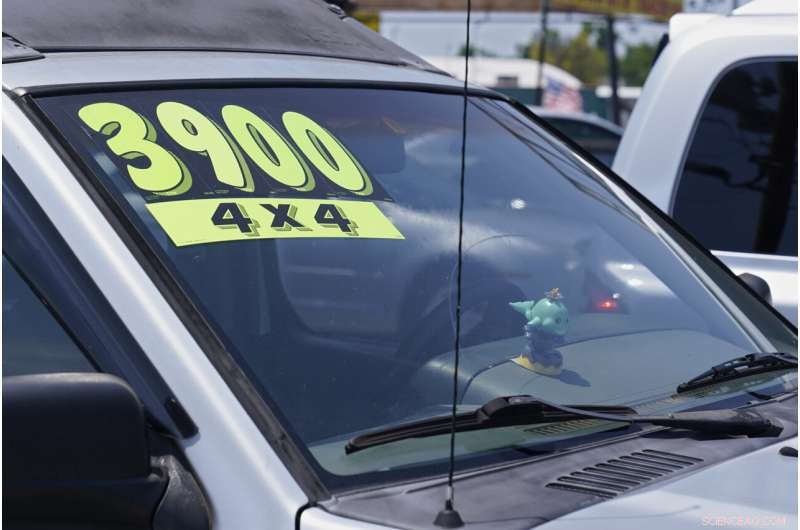
Used cars for sale are on display Thursday, June 24, 2021, in Oklahoma City. Prices for used cars have soared so high, so fast, that buyers are being increasingly priced out of the market. Credit:AP Photo/Sue Ogrocki
Bleak as the market is for used-car buyers, the computer chip shortage has also driven new-vehicle prices higher. The average new vehicle, Edmunds.com says, is edging toward $46,000.
Even so, prices of used cars are likely to edge closer to new ones. Since the pandemic started, used vehicle prices have jumped 42%—more than double the increase for new ones. Last month, the average used vehicle price was 63% of the average new vehicle cost. Before the pandemic, it was 54%.
At this point, Schrier has to tell lower-income buyers that he has very few used vehicles to sell them.
"What used to be a $5,000 car," he said, "is now $8,000. What used to be $8,000 is now $11,000 or $12,000."
Including taxes, fees, a 10% down payment, and an interest rate of around 7.5%, the average used vehicle now costs $520 a month, even when financed for the average of nearly six years, Edmunds calculated.

This June 24, 2021 photo shows used cars for sale in Oklahoma City. Prices for used cars have soared so high, so fast, that buyers are being increasingly priced out of the market. Credit:AP Photo/Sue Ogrocki
Ivan Drury, a senior manager at Edmunds, said that while he doesn't track used vehicle prices relative to household income, he thinks November marked a record "in the worst way possible for affordability."
Monthly payments for the average used vehicle, he noted, were $413 two years ago, $382 five years ago and $365 a decade ago. The November average payment of $500-plus for a used vehicle, Drury said, is about the average that was needed five years ago for a brand-new vehicle.
Used vehicle prices are so high that Karl Hogan of Canonsburg, Pennsylvania, near Pittsburgh, was able last month to quickly sell his 2007 Toyota Tacoma small pickup truck, with more than 170,000 miles on it. Even with the vehicle's age and mileage, a man from Ohio forked over $6,500 for it.
Hogan didn't have to budge from the asking price. When some would-be buyers offered him less money, he told them:"I've got 12 other guys behind you."
A week before the sale, when he bought his new Tacoma, Hogan had been on the other side of the equation. The dealer wouldn't budge from his $38,000 sticker price.
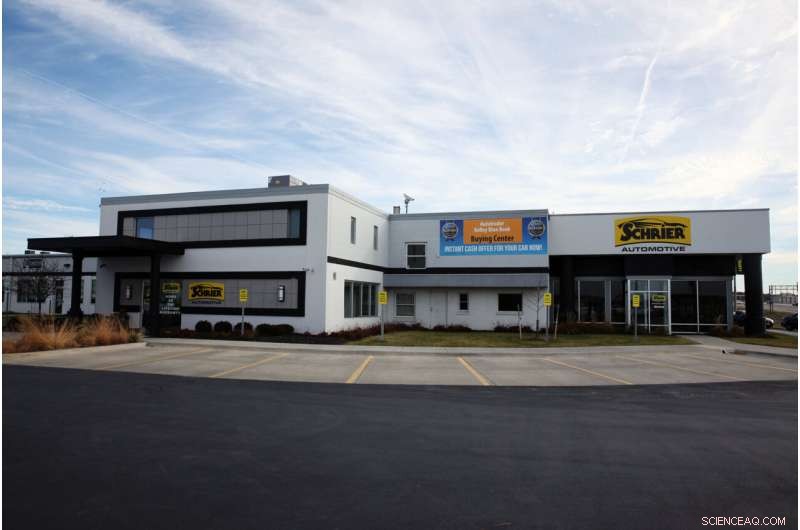
Schrier Automotive in Omaha, Nebraska, sits with a partially empty sales lot caused by high demand for cars on Monday, Nov. 29, 2021. Prices for used cars have soared so high, so fast, that buyers are being increasingly priced out of the market. AP Photo/Grant Schulte)
"If I didn't take it," Hogan said, "there were three people waiting. I couldn't get any off, but I wanted a new truck."
David Paris, a senior manager at J.D. Power, noted that used vehicle prices are directly tied to the cost of new ones. Though some automakers report that the computer chip supply is gradually improving, prices paid by dealers at used vehicle auctions kept rising through November, Paris said.
"We're not seeing any softening in prices, which is extremely rare for this time of the year," he said.
New vehicle dealers have about 1 million vehicles available nationally—scarcely one-third of the normal supply, Paris said. And the vast majority have already been sold.
Given pent-up demand from consumers, prices for new vehicles are expected to remain historically high until the supply returns to around 2 million or 2.5 million and automakers resume discounting, which could take well into 2023. Once new vehicle prices do ease, the pressure on used-vehicle prices would eventually follow.
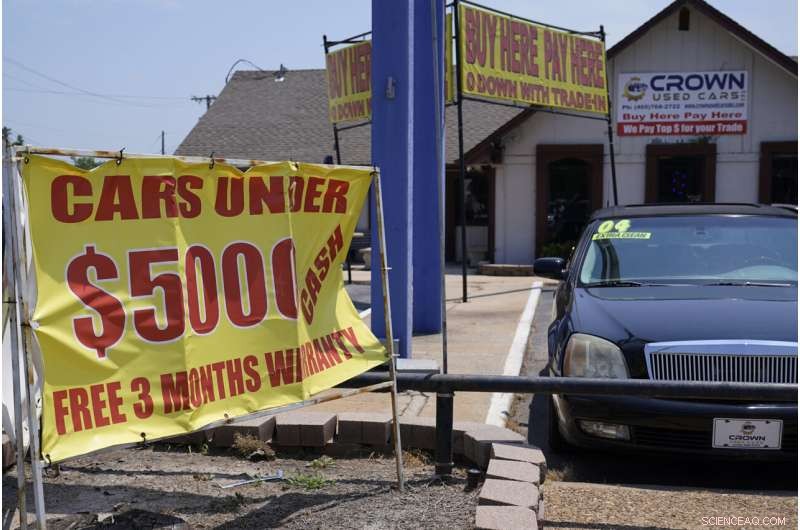
Used cars for sale are pictured Thursday, June 24, 2021, in Oklahoma City. Prices for used cars have soared so high, so fast, that buyers are being increasingly priced out of the market. Credit:AP Photo/Sue Ogrocki
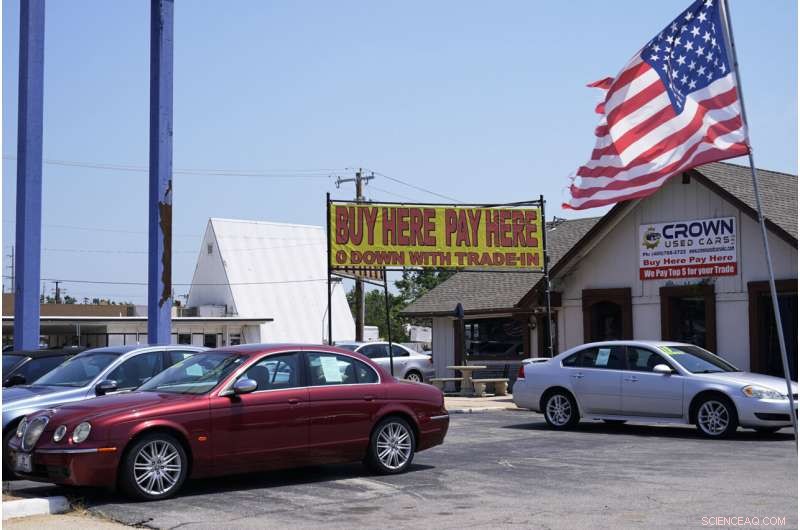
Used cars for sale are pictured Thursday, June 24, 2021, in Oklahoma City. Prices for used cars have soared so high, so fast, that buyers are being increasingly priced out of the market. Credit:AP Photo/Sue Ogrocki
Yet even after that, the availability of vehicles will be tight because traditional sources of used vehicles—autos turned in from leases and trade-ins or sold by rental companies—have essentially dried up.
For the past decade, cars returning from two- and three-year leases were a leading source of almost-new used vehicles. But that was when more than one-third of U.S. new vehicle sales were leases, a figure now down to 22%, said Edmunds' Drury. Because there aren't many new autos, people with expiring leases are often buying those cars once their leases end.
Rental companies, another key source of late-model used cars, can't buy new ones now and are holding the ones they have. Some rental companies are even buying used vehicles. Given all those factors, Paris expects the shortage of used cars to worsen through 2024.
Among the few consumers who stand to benefit are those who want to sell a used car and don't necessarily need to replace it. The average trade-in value in October, Paris said, was $9,000—twice what it was a year earlier.
But for people who have no vehicles to trade in and only modest incomes, the options are few to none. J.D. Power's Paris says that if they can afford it, buyers should consider a new vehicle. He recently managed to get a couple thousand dollars whacked off the sticker price on a new Ram pickup, though he had to travel from the Washington, D.C., area to Philadelphia to reach a willing dealer he had located by searching internet forums.
"If you look hard enough and are willing to wait and travel," he said, "you can find deals across most brands."